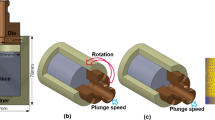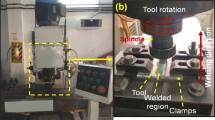Abstract
Direct-drive friction welding of ASTM A106 and AISI 4140 steel tubes has been investigated both experimentally and numerically. A remeshing technique was implemented to accurately simulate highly distorted flashes during the FE simulation. The results revealed that the circumferential thermal expansion led to a higher contact pressure at the inner diameter of the interface and consequently, inner flashes were formed up to 18% larger than the outer ones. The maximum temperature was also located at the outer diameter of the interface in the first moments of the process, then it moved towards the center of the section where there was a balance between the higher slipping rate at the outer section and greater pressure at the inner section of the joint. Validation tests showed the capability of the FE model in terms of temperature, flash cross-section, and axial shortening with the maximum difference of 18.6%.
Graphic abstract



























Similar content being viewed by others
Data availability
The data that support the findings of this study are available from the corresponding author, upon reasonable request.
Code availability
In this study, ABAQUS 16.4-1 and PYTHON 3.4.1 have been used to simulate the direct-drive friction welding using remeshing technique. The PYTHON code of the proposed remeshing algorithm and ABAQUS simulation files are available from the corresponding author, upon reasonable request.
References
Sathiya P, Aravindan S, Haq AN. Mechanical and metallurgical properties of friction welded AISI 304 austenitic stainless steel. Int J Adv Manuf Technol. 2005;26(5–6):505–11.
Sathiya P, Aravindan S, Haq AN. Effect of friction welding parameters on mechanical and metallurgical properties of ferritic stainless steel. Int J Adv Manuf Technol. 2007;31(11–12):1076–82.
Sahin M. Joining with friction welding of high-speed steel and medium-carbon steel. J Mater Process Technol. 2005;168(2):202–10.
Özdemir N, Sarsılmaz F, Hasçalık A. Effect of rotational speed on the interface properties of friction-welded AISI 304L to 4340 steel. Mater Des. 2007;28(1):301–7.
Celik S, Ersozlu I. Investigation of the mechanical properties and microstructure of friction welded joints between AISI 4140 and AISI 1050 steels. Mater Des. 2009;30(4):970–6.
Kimura M, Ichihara A, Kusaka M, Kaizu K. Joint properties and their improvement of AISI 310S austenitic stainless steel thin walled circular pipe friction welded joint. Mater Des. 2012;38:38–46.
Kumar MV, Balasubramanian V. Microstructure and tensile properties of friction welded SUS 304HCu austenitic stainless steel tubes. Int J Press Vessels Pip. 2014;113:25–31.
Balta B, Arici AA, Yilmaz M. Optimization of process parameters for friction weld steel tube to forging joints. Mater Des. 2016;103:209–22.
Służalec A. Thermal effects in friction welding. Int J Mech Sci. 1990;32(6):467–78.
Moal A, Massoni E. Finite element simulation of the inertia welding of two similar parts. Eng Comput. 1995;12(6):497–512.
D’Alvise L, Massoni E, Walløe S. Finite element modelling of the inertia friction welding process between dissimilar materials. J Mater Process Technol. 2002;125:387–91.
Nguyen T, Weckman D. A thermal and microstructure evolution model of direct-drive friction welding of plain carbon steel. Metall Mater Trans B. 2006;37(2):275–92.
Bennett C. Finite element modelling of the inertia friction welding of a CrMoV alloy steel including the effects of solid-state phase transformations. J Manuf Process. 2015;18:84–91.
Li W, Wang F. Modeling of continuous drive friction welding of mild steel. Mater Sci Eng A. 2011;528(18):5921–6.
Wang L, Preuss M, Withers P, Baxter G, Wilson P. Energy-input-based finite-element process modeling of inertia welding. Metall Mater Trans B. 2005;36(4):513–23.
Grant B, Preuss M, Withers P, Baxter G, Rowlson M. Finite element process modelling of inertia friction welding advanced nickel-based superalloy. Mater Sci Eng A. 2009;513:366–75.
Nan X, Xiong J, Jin F, Li X, Liao Z, Zhang F, et al. Modeling of rotary friction welding process based on maximum entropy production principle. J Manuf Process. 2019;37:21–7.
Geng P, Qin G, Zhou J. Numerical and experimental investigation on friction welding of austenite stainless steel and middle carbon steel. J Manuf Process. 2019;47:83–97.
Jin F, Li J, Du Y, Nan X, Shi J, Xiong J, et al. Numerical simulation based upon friction coefficient model on thermo-mechanical coupling in rotary friction welding corresponding with corona-bond evolution. J Manuf Process. 2019;45:595–602.
Bennett C, Hyde T, Shipway P. A transient finite element analysis of thermoelastic effects during inertia friction welding. Comput Mater Sci. 2011;50(9):2592–8.
Incropera FP, Lavine AS, Bergman TL, DeWitt DP. Fundamentals of heat and mass transfer. Hoboken: Wiley; 2007.
Bouarroudj E-O, Chikh S, Abdi S, Miroud D. Thermal analysis during a rotational friction welding. Appl Therm Eng. 2017;110:1543–53.
Systèmes D. ABAQUS 6.14, ABAQUS/CAE user’s guide. Providence, RI; 2014.
Choo S-H, Lee S, Golkovski MG. Effects of accelerated electron beam irradiation on surface hardening and fatigue properties in an AISI 4140 steel used for automotive crankshaft. Mater Sci Eng A. 2000;293(1–2):56–70.
de Albuquerque VH, Silva CC, Moura CR, Aguiar WM, Farias JP. Effect of nonmetallic inclusion and banding on the success of the two-layer temper bead welding technique. Mater Des. 2009;30(4):1068–74.
Navas VG, Gonzalo O, Quintana I, Pirling T. Residual stresses and structural changes generated at different steps of the manufacturing of gears: effect of banded structures. Mater Sci Eng A. 2011;528(15):5146–57.
Funding
Not applicable.
Author information
Authors and Affiliations
Corresponding author
Ethics declarations
Conflict of interest
The authors declare that they have no known competing financial interests or personal relationships that could have appeared to influence the work reported in this paper.
Additional information
Publisher's Note
Springer Nature remains neutral with regard to jurisdictional claims in published maps and institutional affiliations.
Rights and permissions
About this article
Cite this article
Khosrowshahi, J.H., Sadeghi, M.H. & Rasti, A. Numerical simulation of plastic deformation in direct-drive friction welding of AISI 4140 and ASTM A106 steel tubes. Archiv.Civ.Mech.Eng 20, 116 (2020). https://doi.org/10.1007/s43452-020-00113-2
Received:
Revised:
Accepted:
Published:
DOI: https://doi.org/10.1007/s43452-020-00113-2




